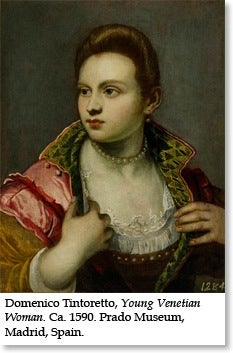
Veronica Franco mingled with the cultural elite of Venice in her work as a courtesan and poet. Among other literary and artistic figures, Franco befriended Jacopo Tintoretto (1518-1594), a native-born painter who was renowned for his portraits of the Venetian nobility and his religious narratives.
Portrait of a Lady, painted around 1574, is often attributed to Tintoretto or one of his followers. It depicts a woman from the bust up. Her eyes gaze away from the spectator to her left. A crown of loose red curls adorns her head. She is clad in layers of clothing–a white ruffled camicia (a traditional undershirt), a rose bodice with embroidery and beading, a lace overlay (on her shoulders), and a dark velvet wrap. She also wears delicate bow-shaped earrings, a pearl choker, and, stretching diagonally across her chest in ancient Roman Style, a long pearl and jewel necklace.

There is debate among art historians as to the subject of Portrait of a Lady. Some argue that, while not explicitly erotic, it represents a courtesan. The woman’s expensive jewelry and sumptuous clothing are certainly indicative of a courtesan’s elegance and refinement. The flush of her cheeks, the looseness of her garments (revealing the very edge of her left nipple), and the milky white quality of her skin also signify feminine sensuality and ideal beauty. The woman may even clutch her dark velvet wrap as a gesture of display or as if she is about to disrobe.
But the painting also lacks many of the trappings of courtesan portraiture. There are no direct references to Flora, Venus, or other mythological figures and there are no iconographic symbols of fertility or sexuality. In many respects, the painting feels like a traditional portrait of a lady. The subject seems to exist in her own time; she emerges, upright and minimally posed, from a dark and unspecified background. She also seems in control; in looking away from the spectator, she refuses his gaze. She may be beautiful, but she is more than just an object of masculine desire.

Some art historians point to Veronica Franco, more specifically, as the subject of Portrait of a Lady. In her Lettere familiari a diverse (1580), Franco refers to her portrait painted by Jacopo Tintoretto. However, there are other portraits by Jacopo and his son Domenico Robusti — Young Venetian Woman and Lady Baring Her Breasts — whose subjects bear an uncanny resemblance to the sitter of Portrait of a Lady. This has led other art historians to believe that the portrait Franco refers to in her letter might be a different canvas than Portrait of a Lady. The debate should have ended when art historians discovered that the back of Portrait of a Lady bears the inscription “V. FRANCO.” However, it is not possible to confirm when the inscription was written.
The specific subject, artist, and meaning of Portrait of a Lady continue to elude art historians. If this is the image of Veronica Franco, however, perhaps the complex balance of sensuality and restraint serves a psychological purpose. Perhaps the painter captures Franco’s ability both physically and intellectually to seduce.
A special thanks to the Worcester Art Museum for providing us with information about the Franco portrait in their collection.
© 2013 Veronica Franco Project